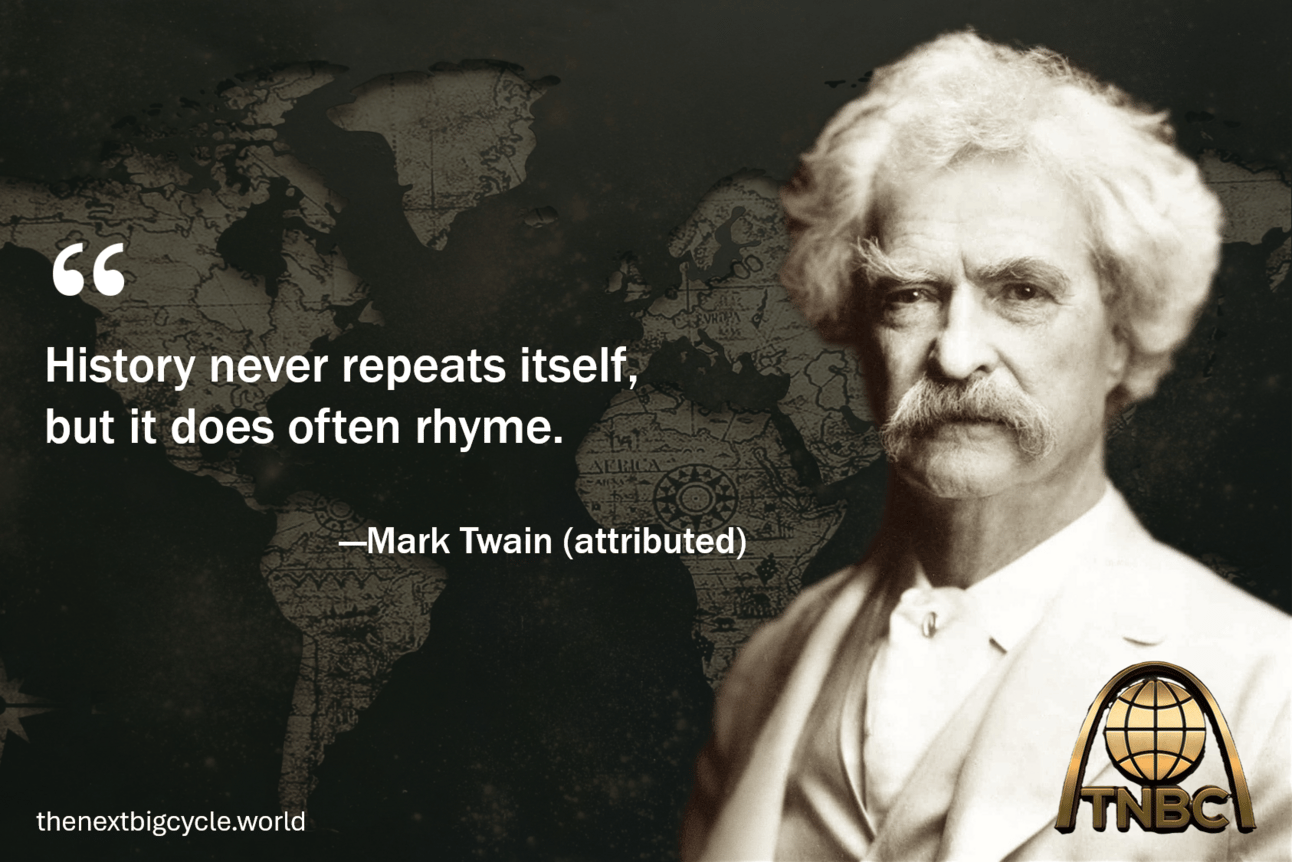
History never repeats itself, but it does often rhyme. - Mark Twain (attributed)
About this series
In the series History Rhymes, we zoom in on specific historical events that reflect themes more universally than isolated incidents. Our goal is to raise awareness of how similar patterns may be recurring in the present day.
Context in Time
This quote - though its exact origin is unclear - reflects a timeless truth: while events don’t recur identically, the underlying human behaviors, power dynamics, and institutional patterns often reemerge in similar forms.
The idea is echoed in the work of historians like Thucydides, philosophers like Hegel, and modern thinkers like Ray Dalio and Strauss & Howe. Each of them sees history as cyclical, driven by debt, conflict, innovation, inequality, and generational psychology.
This concept is central to understanding how and why empires rise and fall, and how world orders shift over time - whether it's the Roman Empire, the British Empire, or the post-WWII American-led global system.
The Message
History may not offer a perfect blueprint for the future, but it provides a pattern book. It tells us what warning signs to look for, what stress points precede collapse or renewal, and how societies often respond under pressure.
The rhyme isn’t the exact same melody - but the beat is familiar. And if we learn to recognize it, we can prepare rather than react.
Echoes in the Present — and What to Watch
Geopolitical Realignment
Then: In past cycles, declining empires like Rome, the Ottoman Empire, or the British Empire gradually lost control of their currency, trade routes, and military reach.
Now: The U.S. is facing challenges to its global dominance from a rising China, a strengthening BRICS+ bloc, and shifting alliances (e.g., Mideast realignment, EU fractures).
Watch for: De-dollarization trends, naval chokepoint conflicts (e.g., Red Sea, Taiwan), military overextension, NATO cohesion cracks.
Economic Instability and Debt Cycles
Then: The 1929 crash and Great Depression were followed by massive social upheaval and world war. The 1970s stagflation ushered in a new monetary regime.
Now: We are exiting an era of artificially low interest rates, rising sovereign debt, and widening wealth gaps—echoes of both the 1930s and 1970s.
Watch for: Inflation volatility, central bank U-turns, credit market stress, and rising social unrest linked to cost-of-living pressures.
Institutional Distrust and Cultural Fracture
Then: In times of transition, belief in institutions erodes—like in Weimar Germany or post-Vietnam America.
Now: Polarization, disinformation, and declining trust in government, media, and education systems mirror late-stage empire fatigue.
Watch for: Censorship vs free speech battles, rise of populism, generational disconnects, and state vs tech power struggles.
Generational Turning Points (The Fourth Turning)
Then: Major crises (American Revolution, Civil War, WWII) follow roughly 80–100-year cycles - a “fourth turning” that resets institutions and values.
Now: We are deep into a Fourth Turning (2008–2030), facing compounding global crises that will likely define the next societal order.
Watch for: Emergence of new political ideologies, a major global conflict or restructuring event, and a generational shift in leadership norms.
Question to Challenge
If you had the chance to travel back in time to 1913, 1938, or 1969, what warning would you give? Now turn the question around: what might your future self wish they could warn you about today?
Think Forward: Preparing for the Rhyme
Understanding that we’re not in a moment of replication but rhyme is powerful. It means the story isn’t set - but the characters and themes are familiar. That gives us a strategic advantage - if we’re paying attention.
Your toolkit for the new world order:
Study history not as nostalgia, but as signal.
Diversify knowledge, networks, and assets.
Question narratives - but don’t fall into cynicism.
Prepare mentally for change - not stability.
Pay attention to the edges - shifts often begin in fringe movements, unaligned states, or overlooked technologies.
The changing world order is not just a macroeconomic trend—it’s a test of our critical thinking, resilience, and ability to see through the fog of repetition and recognize the rhyme.